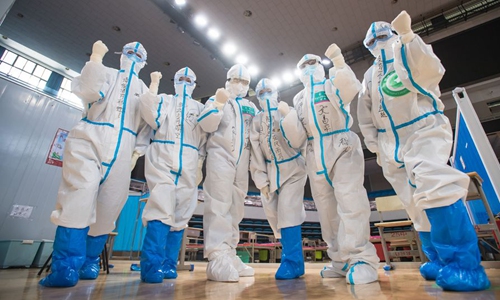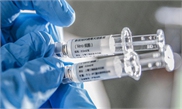
Medical workers pose for photos after seeing cured patients off at the Wuchang temporary hospital in Wuhan, Central China's Hubei Province on March 10. Photo: Xinhua
Key figures in the Chinese Center for Disease Control and Prevention (China CDC) are set to make public a summary of their anti-epidemic experiences since COVID-19 first emerged in December 2019.
Jointly produced by a dozen experts including Gao Fu, director of China CDC and its chief epidemiologist Wu Zunyou, the paper describes the emergence of the pandemic, details the first 100 days of China's response in the phase 1 containment strategy followed by phase 2 containment, and briefly highlights areas of focus for the future.
The paper is still in the process of online publication. The Global Times obtained a copy from China CDC on Tuesday.
China CDC experts in the paper noted that specific, simple and pragmatic strategies have been used in China for risk assessment, prioritization, and deployment of resources. Details of implementation at different risk levels are shared in the paper.
The involvement of society in mounting a whole-country-response and challenges experienced with logistics and supply chains are described in the paper. Methods and approaches China is employing to cautiously restart social life and economic activities are also outlined.
What has been most stressed in phase 1 is "mobilizing everything," which means taking a "whole-of-government, whole-of-society approach." According to the paper, the phase 1 containment strategy was launched on January 15, 2020. A supervisory team was stationed in Wuhan on January 27, and reached all provinces on February 3. By 29 January, all provinces had declared public health emergencies and launched local phase 1 containment strategies.
As the quantity and quality of information improved, China conducted strategies called "4 Lines of defense" and "4 Levels of risks." They guided allocation of resources and public health assets to prevent, detect, isolate, treat, and report cases and to trace and quarantine contacts, read the paper.
Without safe and effective treatments or a proven vaccine, China had to rely solely on traditional, non-pharmacological (public health) interventions (NPIs). Controlling sources of infection, blocking transmission, and protecting susceptible populations were thus crucial.
Therefore, China's public health sector was given a mission summed up by the "4 Earlies" (early detection, early reporting, early isolation/quarantine, and early treatment). It was quickly implemented in Wuhan, and generated lots of information, which improved the evidence base for strategic decision-making and treatment and prevention protocols.
To support the phase 1 containment strategy, the Chinese government called upon its 1.4 billion citizens to participate. Grassroots staff from communities and subdistricts, police and other security staff were regarded as the "5 Reliable Forces." Citizens assisted with COVID-19 screening, controlling movement of people and goods, supervising critical activities, and helping with education and communication.
Phase 2 started on February 17, when China was 23 days beyond the peak of its epidemic curve and the number of daily new cases had fallen below 800 nationwide. Asymptomatic infection was poorly understood, much of the nation remained unexposed and susceptible, and the durability of immunity was unknown.
This phase 2 containment strategy aimed to avoid a resurgence in local cases, prevent importation of cases (which had been increasing since the first imported case was reported on January 30), and facilitate the restarting of work and life.
During the first 100 days of COVID-19 in China, the paper said the nation experienced a skyrocketing outbreak, but quickly initiated a targeted, tailored, and pragmatic response strategy that has brought the epidemic under control.
China CDC experts said that there are still many unknowns with the virology of this coronavirus. No therapeutics are yet proven safe and effective, and vaccines are still at least one year away and thus international cooperation must be fostered.
Global Times


